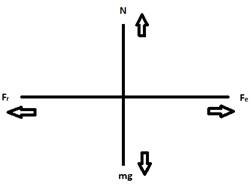A particle A having a charge of 2.0 × 10–6 C is held fixed on a horizontal table. A second charged particle of mass 80g stays in equilibrium on the table at a distance of 10 cm from the first charge. The coefficient of friction between the table and this second particle is μ = 0.2. Find the range within which the charge of this second particle may lie.
Given:
Charge of the particle A : q1 = 2.0 × 10–6 C.
Mass of the second charged particle i.e. B:
m=80 g=80×10-3 kg.
Separation between both the charged particles:
r = 10 cm = 0.1 m
Coefficient of friction between the table and this second particle: μ = 0.2
Formula used:
Let the charge of the particle B be q2
We use Coulomb’s law:![]() Where Fe is the electrostatic force on b due to A, k is a constant .
Where Fe is the electrostatic force on b due to A, k is a constant .
k = ![]() = 9× 109 Nm2C-2 and r is the distance between two charges.
= 9× 109 Nm2C-2 and r is the distance between two charges.
The Friction force is given as:
Fr = μN= μmg
Here, μ is the coefficient of friction, N is the normal reaction of table to the particle. N=mg.
It is given that particle B is at equilibrium with the table,
Thus
Fe = Fr![]()
![]()
![]()
![]() Hence, the range within which the charge of the second particle lies is ± 8.71× 10-8 C. Since, charge can be positive or negative, thus ± .
Hence, the range within which the charge of the second particle lies is ± 8.71× 10-8 C. Since, charge can be positive or negative, thus ± .